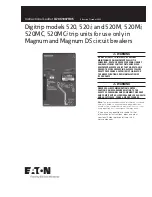
- 1 -
The HUM8 Series Molded Case Circuit Breaker (hereinafter referred to as “circuit
breaker”) is the high-tech product in the 21st century. This product is characterized
by advanced design, reliable performance, high technical indicators, beautiful
appearance, and small size.
1 Purpose and Scope of Application
This circuit breaker is suitable for the power system with AC 50 Hz, rated voltage up
to 690 V, and rated current up to 800 A. It is used to distribute electric energy, protect
circuits and power supply equipment from overload, short circuit, undervoltage and
other faults, and prevent the infrequent operation of the motor.
2 Standards Followed
The product complies with GB/T 14048.2
Low-voltage Switchgear and Controlgear
— Part 2:
Circuit-breakers, and IEC 60947-2
Low-voltage Switchgear and
Controlgear — Part 2:
Low-voltage Circuit Breakers
, etc.
3 Model Description
Overload alarm without tripping is denoted by “I”
Flashover distance: No code with flashover; Code W without flashover
Wiring method:
No code with wiring in front of the plate; Code H with
wiring behind the plate, C for plug-in connection, and CH
for pull-out connection (only for 3 poles)
No code for conventional products, and Code Y with the special release
with prepaid kilowatt-hour meter
Application code: No code for power distribution; Code 2 for motor protection
Internal accessory code (see Table 2)
Overcurrent release type (see Table 1)
Type of neutral pole (N pole) of 4-pole circuit breaker (note)
Number of poles of circuit breaker: 2 for 2 poles; 3 for 3 poles; 4 for 4 poles
Circuit breaker rated current In (A) (see Table 3)
Operation mode:
No code for handle direct operation;
Code M for electrical operation;
Code Z for handle rotation operation
Short-circuit breaking capacity level: C — Basic type; S — Standard type;
H — Advanced type; U — Current limiting type
Shell frame level rated current Inm (A) (see Table 3)
Design number
Molded Case Circuit Breaker
Enterprise code
Note: In 4-pole products, two types are provided for the neutral pole (N pole):
Type A: The N pole is not equipped with an overcurrent release and is normally on,
and is not opened/closed with the other three poles.
Type B: The N pole is not equipped with an overcurrent release, and is closed/opened
with the other three poles.
Table 1 Type of the overcurrent release
Serial
number
Name
Description
1
Delay release
With the overcurrent inverse time limit protection characteristic
2
Instantaneous
release
i.e. electromagnetic release, with the overcurrent instantaneous
operation protection characteristic
3
Complex release
With the above two functions
























